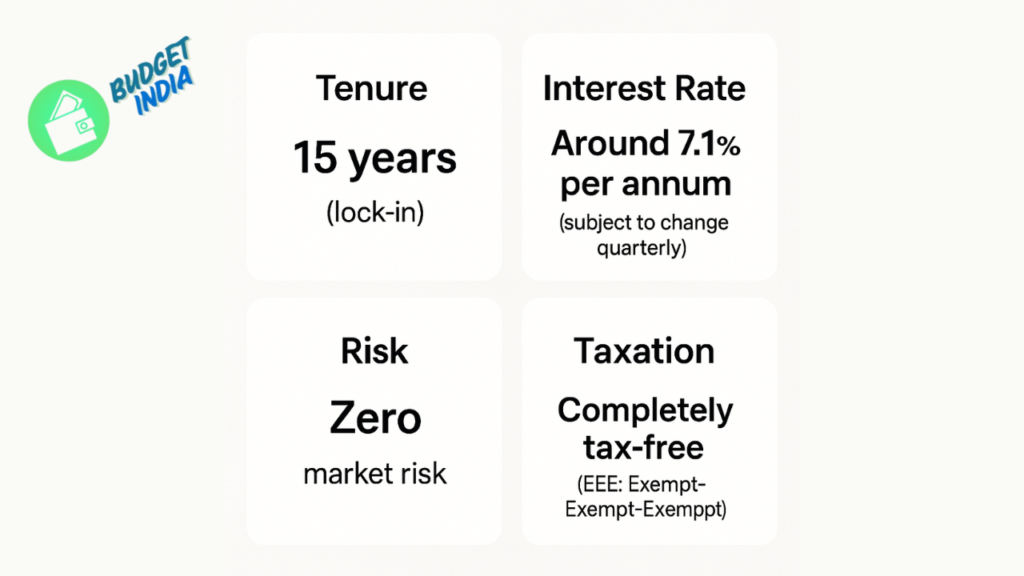You don’t have to look far to understand why investment planning has become a pressing priority for India’s middle-class families in 2025. With rising inflation, volatile markets, and increased household expenses, merely saving money in a bank account just doesn’t cut it anymore. Families are realizing that unless their money works harder than they do, long-term financial security will remain elusive.
But where do you begin? The Indian financial ecosystem is crowded with options—mutual funds, gold, real estate, fixed deposits, and more. And for the middle class, the challenge isn’t just about earning returns. It’s about protecting capital, maintaining liquidity, managing risk, and ensuring long-term stability.
Let’s decode the best investment options that are not only safe but also practical for salaried individuals and middle-income households in 2025.
- 1. Public Provident Fund (PPF): A Long-Term Safety Net
- 2. Employee Provident Fund (EPF): The Automatic Saver’s Ally
- 3. SIP in Equity Mutual Funds: Growth with Discipline
- 4. National Pension System (NPS): Retirement with Tax Efficiency
- 5. Recurring Deposits (RDs): Budget-Friendly Saving
- 6. Sovereign Gold Bonds (SGBs): Better Than Physical Gold
- 7. Fixed Deposits: Not Dead Yet
- 8. Real Estate: Think Beyond the Hype
- 9. Digital Gold and UPI-linked Micro-Investments
- 10. Term Life Insurance (Non-Investment, But Vital)
1. Public Provident Fund (PPF): A Long-Term Safety Net
PPF is the gold standard of conservative investment in India. It offers guaranteed returns, tax benefits under Section 80C, and complete capital protection.
- Tenure: 15 years (lock-in)
- Interest Rate (2025): Around 7.1% per annum (subject to change quarterly)
- Risk: Zero market risk
- Taxation: Completely tax-free (EEE: Exempt-Exempt-Exempt)
Why it works for the middle class?
Because it’s predictable. You can’t afford to lose principal when planning for kids’ education or retirement. PPF ensures that even if you don’t beat the market, you don’t lose sleep either.

2. Employee Provident Fund (EPF): The Automatic Saver’s Ally
For salaried individuals, EPF is the most underrated part of their investment planning. With employer contribution, compounding interest, and partial withdrawal options, this is a built-in retirement fund.
- Contribution: 12% of basic salary + employer match
- Interest Rate (2025): 8.15% (likely)
- Liquidity: Partial withdrawals allowed for specific purposes
- Taxation: Tax-free on maturity if service > 5 years
It’s not glamorous. But it quietly builds a corpus you’ll thank yourself for in your 50s.
3. SIP in Equity Mutual Funds: Growth with Discipline
This is where the magic of compounding begins to work. Systematic Investment Plans (SIPs) in equity mutual funds are tailor-made for middle-class investors with long-term goals. You don’t need ₹1 lakh to begin. ₹500/month is enough.
- Ideal For: Long-term wealth building (10+ years)
- Returns: 10–14% annualized (historical average)
- Risk: Moderate to high
- Taxation: LTCG above ₹1 lakh taxed at 10%
If you can stay invested through market cycles and avoid panic-selling, equity SIPs can create real wealth.
4. National Pension System (NPS): Retirement with Tax Efficiency
If you’re thinking long-term, NPS is hard to ignore. It combines equity and debt exposure, offers tax deductions beyond Section 80C, and locks in funds till retirement.
- Returns: 8–11% historical returns
- Taxation: Partial tax-free withdrawal; annuity portion taxable
- Extra 50,000 Deduction: Under Section 80CCD(1B)
NPS isn’t just an investment. It’s retirement planning wrapped inside investment planning.
5. Recurring Deposits (RDs): Budget-Friendly Saving
You may not have lump sum funds to lock away, but RDs offer the discipline of monthly savings with guaranteed returns.
- Tenure: 6 months to 10 years
- Interest: 6–7.5% (varies by bank)
- Risk: Very low
- Taxation: Interest fully taxable
Ideal for those who need liquidity in a year or two but still want to earn better than a savings account.
6. Sovereign Gold Bonds (SGBs): Better Than Physical Gold
Indians love gold, but lockers don’t earn interest. Enter SGBs—government-backed bonds denominated in grams of gold, offering both capital appreciation and interest.
- Interest Rate: 2.5% annually (plus gold price gains)
- Tenure: 8 years (exit after 5 years allowed)
- Taxation: Capital gains tax exempt if held till maturity
SGBs are not only safer than physical gold but also more rewarding—especially if you’re looking to hedge inflation or diversify.
7. Fixed Deposits: Not Dead Yet
Falling out of favour among young investors, but still a solid bet for conservative households. Banks, NBFCs, and post offices still offer decent FD rates in 2025.
- Interest Rate: 6%–7.5%
- Tenure: Flexible
- Liquidity: Easy premature withdrawal (with penalty)
- Taxation: Interest fully taxable (TDS applicable if > ₹40,000/year)
Use FDs for emergency buffers, not long-term growth.
8. Real Estate: Think Beyond the Hype
Real estate remains emotionally satisfying but financially tricky. High ticket size, illiquidity, and maintenance costs are real issues. But in growing Tier-2 and Tier-3 cities, it can still be a rewarding long-term asset.
- Returns: Location-dependent
- Risks: Regulatory delays, lack of transparency
- Liquidity: Very low
Make sure your investment planning includes real estate only after your other basics (PPF, mutual funds, term insurance) are sorted.
9. Digital Gold and UPI-linked Micro-Investments
In 2025, fintech platforms now allow micro-investing in gold, mutual funds, and more through UPI apps. Think of it as investing your spare change.
- Minimum Investment: ₹1
- Convenience: Fully digital
- Returns: Depends on product (gold, equity, debt, etc.)
For those who think they’re “too broke to invest,” this changes the game.
10. Term Life Insurance (Non-Investment, But Vital)
While not a return-generating instrument, term insurance is an investment in your family’s security. Without it, everything else can fall apart.
- Premiums: As low as ₹500/month
- Coverage: ₹50 lakh to ₹1 crore+
- Returns: None (pure protection)
- Tax Benefits: Under Section 80C
Don’t mix insurance with investment. Just buy term cover, and sleep better at night.
Conclusion: Investment Planning Is Not a One-Size-Fits-All
Middle-class families in India must juggle stability and ambition. You want to play it safe—but not so safe that your money dies in a savings account. That’s where investment planning steps in.
Start small. Automate where possible. Diversify smartly. And remember—your biggest edge isn’t market timing, but time in the market.
FAQs:
1. What is the safest investment option for middle-class families in 2025?
Public Provident Fund (PPF) is considered one of the safest options with guaranteed returns and tax benefits.
2. Is SIP a good choice for beginners?
Yes, especially for long-term goals like children’s education, marriage, or retirement. SIPs in equity mutual funds offer flexibility and higher returns.
3. How much should a middle-class family invest monthly?
Start with 20% of your monthly income, and increase it as your earnings grow. Even ₹1,000/month can build long-term wealth if invested right.
4. Can I invest in multiple schemes simultaneously?
Absolutely. In fact, diversification is key to smart investment planning. Mix safe and growth-oriented options.
5. Are real estate investments still worth it in 2025?
Only if you have surplus funds, a long horizon, and are buying in growth corridors. It should not be your first investment priorities.






Leave a Reply